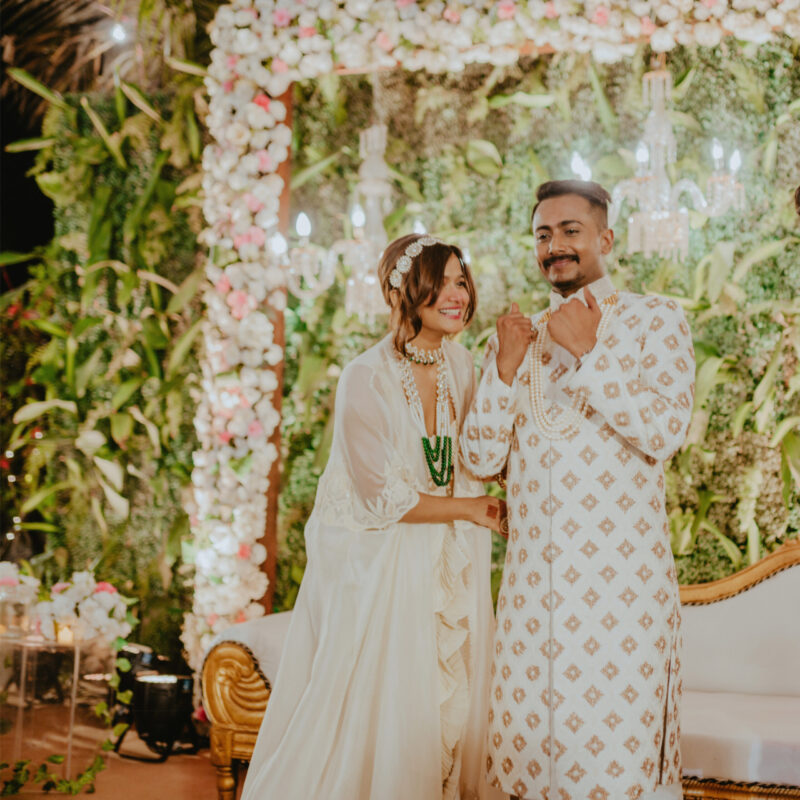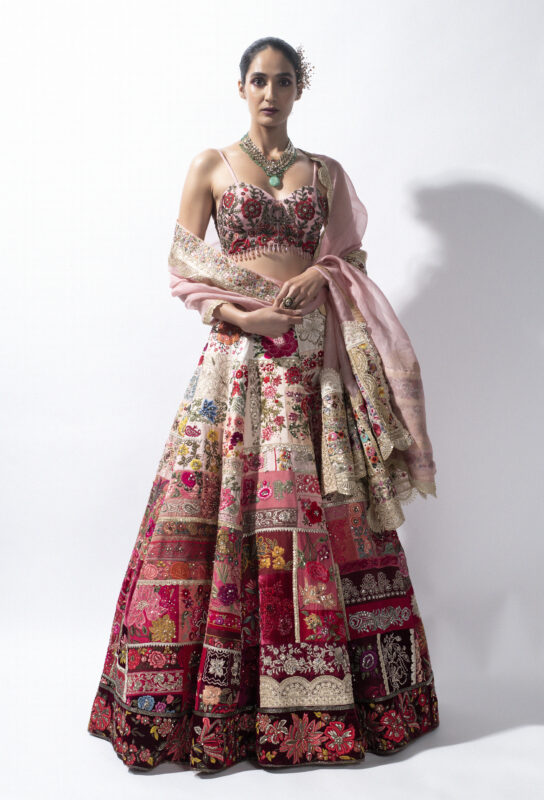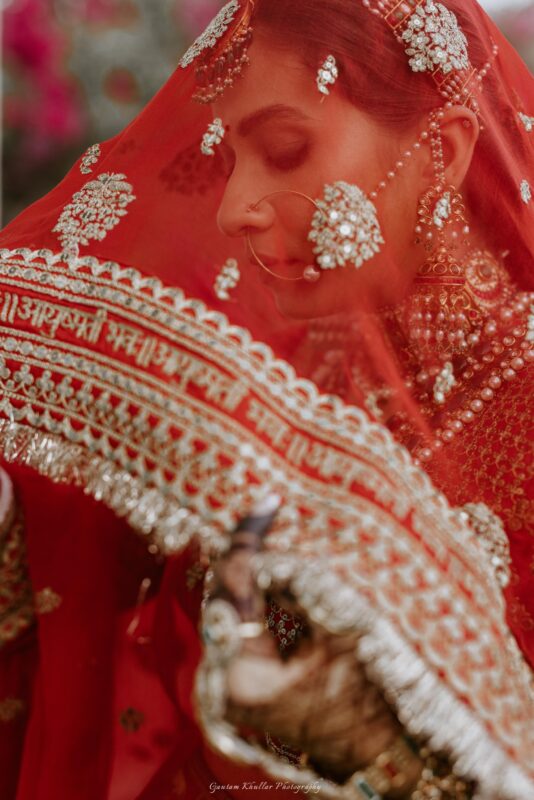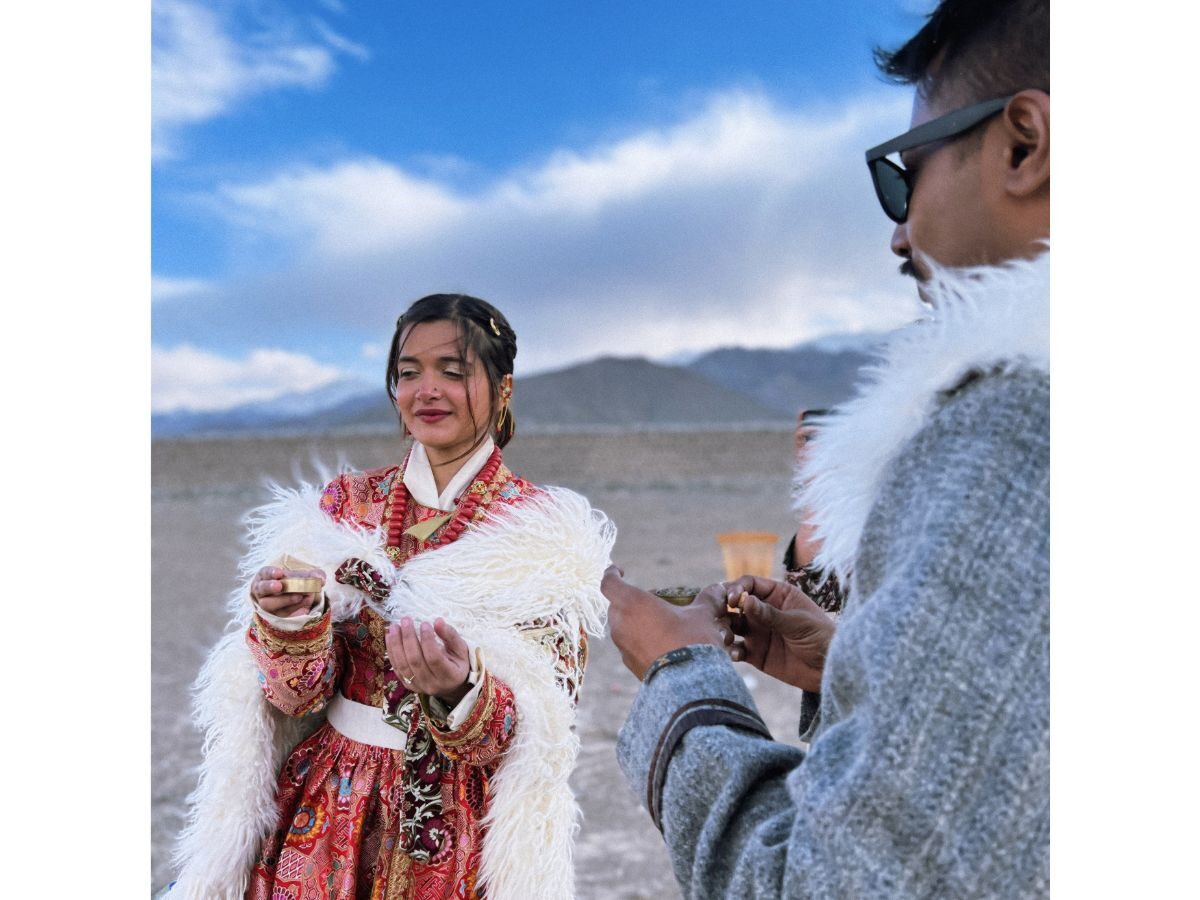In the last century, high-flying celebrities as well as well-heeled high society could not imagine wearing anything other than elaborate neckpieces and embroidered lehengas or saris at their weddings. It had to be all gold or floral, just like princesses of yore.
But now, millennials have started asserting their individuality. Take Delhi-based creative director Shruti Sitara Singh, who wore a Ladakhi dress crafted by designer Stanzin Zilzom: a silk brocade robe known as sulma, and a kos or goncha, which is a hand-sewn dress with a round neck and long sleeves that opens in the front and is held together by a narrow belt.
“Under the robe, women wear a blouse which has a soft collar that rolls over the neck and the sleeves of the robe. The look is completed with logor or sbog – a cape which has a rich silk brocade on the outer surface. The piece makes its way to Ladakh from China and Benaras”, she explains.
For the reception, she chose a buttery white skirt, jacket and bralette by Anamika Khanna. And keeping the weather in mind, she chose a Sakshi and Kinni skirt and top for mehndi, not worrying about what the family will think about modesty.

“I wanted to pay homage to the artisans of Kutch, so the dupatta was Sohail Khatri. I wore no diamonds or jadau sets; instead, I chose silver jewellery I got from Sarojini Nagar many years ago”, she laughs.
She admits that her mom did buy her some gold pieces for her trousseau. Interestingly, no make-up artist was hired, as all she needed was kajal and a bold mouth!
Totally offbeat
What to make of this trend of throwing tradition to the winds? JJ Valaya puts it succinctly: “Broadly speaking, there are two kinds of brides in the capital – the intellectual and the traditional.” Meaning, probably, those who apply their minds to expressing their individuality and those who succumb to social pressure.
Couturier Varun Bahl explains why this flight of independence is so essential a part of the fast-changing scenario where both these types of brides co-exist: one who shuns the glamour and the other who embraces it wholeheartedly.
“Families, I have noticed, are less involved now. The couple is making the choices, wedding wear is mostly universal, even though I would have to admit Delhi likes it ostentatious”, says Bahl.

This is certainly true in the case of Shruti Sitara Singh, whose choices were supported by her husband, music producer Sarvesh. They made it clear they both wanted to move away from the set template, unlike her own sister Nidhi’s vows. The sisters were raised in a conventional family from UP.
The influence of Bollywood, however, is still strong. “I liked what Alia Bhatt wore. She even had her favourite flower Baby’s Breath for the jaimala. They incorporated things they value”, says Shruti.
The young couple in fact preferred to go completely offbeat by literally and metaphorically taking the road less travelled – to Ladakh. They also decided to break free from the restrictions of a five-star hotel.
Shruti and Sarvesh tied the knot but skipped the kanyadaan, seven pheras and mangalsutra rituals. Instead, they chose ‘sand’ and ‘blanket’ rituals.
In the sand ritual, the couple takes sand from their respective vessels and combines the grains into one. This ritual represents the creation of a new union or family. In the blanket ritual, blue blankets are draped over the couple’s shoulders, symbolizing the sorrow before their marriage. In some communities, the blanket ritual symbolizes the comfort and love the couple will bring each other.
“Sarvesh had shot his first album in Ladakh, it was a special place. There were just four people, no extended family or even parents; the groom’s brother officiated at the wedding”, she smiles.
Stanzin had done the music for Sarvesh’s show and it was an unforgettable connection. Despite all the challenges in getting married, where the oxygen is low, the cold is extreme, and the groom is running out of breath till he acclimatizes, the couple kept it local and organic.
“We bought things from the neighbourhood market for the ceremony to incorporate their culture into our vows”, she says.
Sabyasachi, of course
Not everyone is so dismissive of tradition. Delhi-based stylist Tanishq Malhotra, who got married to her namesake Tanishq Gulabani, a Hyderabadi from a reputed jeweller family, had to have all the bells and whistles. “I’m a muted and ivory kind of person, and that’s what I went for. But the wedding had to have the ceremonious red”, says Tanishq. It took a year of planning, and because of Covid, the wedding got delayed for many months.

Her wedding outfit was predictably a Sabaysachi Mukherjee. She had styled the actor Aditi Rao Hydari for a magazine cover shoot and fell in love with the Kolkata-based style maverick’s recent wedding collection. She knew she would be a Sabya bride, and selected her wedding lehenga from a swatch, as she knew what exactly would work for her petite frame.
“For the cocktail, I chose a Gaurav Gupta gown, with 200 metres of organza sans any embellishment”, she adds. She calls it ‘austere’, with easy hues and gossamer fabric that celebrates pure love.
Malhotra also did a variation on Alia Bhatt’s whimsical decision to get her wedding date embroidered on her outfit. Her reception outfit created by Jade by MK had a detachable trail with a special quote: “Distance means nothing when someone means everything”, a sign of their long-distance courtship.
“Monica, the designer, helped me include young artisans to do the ek taar (embroidery done with single strand of slim metal, usually in sync with crystal elements) work on the outfit, as being a stylist, I wanted a tribute to craftspeople,” she smiles.
Unconventional choices
The key to modern weddings is personalisation. Each bride wants something unique.
With every wedding outfit, Malhotra chose to wear sneakers instead of high heels, so that she could dance. “I was a bride who partied every night and danced till morning. I knew high heels would injure my feet. I selected Jimmy Choos, Air Jordans and Kanye West’s Yeezy. It was comfort over fashion this time”, she admits.
Not being too tall, she was warned by designers that giving up heels may affect the entire look, but she was adamant, and is confident it worked.
“I wore two dupattas with my wedding joda, but after the rituals, I quickly abandoned them to match my steps with my now husband”, she says. She also left behind the “bun with flowers” for her long tresses and went for an embellished braid.
Malhontra wants to keep every wedding outfit of hers for her daughter or son’s wedding. She calls these investments – an heirloom she will pass on to the next generation. But won’t her offspring resent the heavy hand of family pressure in making such decisions – just as she did?
For more stories that cover the ongoings of Delhi NCR, follow us on:
Instagram: instagram.com/thepatriot_in/
Twitter: twitter.com/Patriot_Delhi
Facebook: facebook.com/Thepatriotnewsindia





